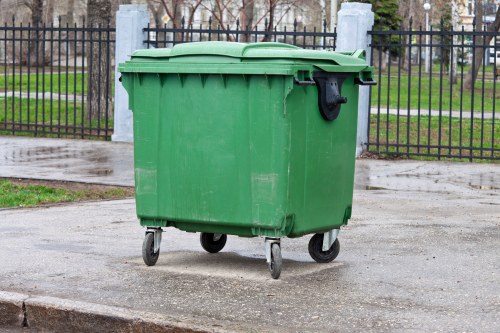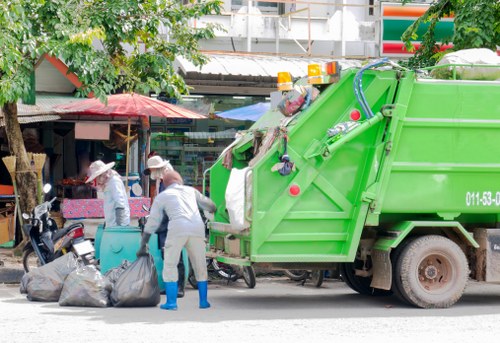Effective Construction Waste Clearance in Lambeth

Construction projects in Lambeth generate a significant amount of waste, which, if not managed properly, can lead to environmental degradation and legal issues. Effective construction waste clearance is essential not only for maintaining cleanliness and safety on-site but also for ensuring compliance with local regulations.
Proper waste management practices help in minimizing the environmental impact of construction activities. By adopting efficient clearance methods, construction companies can promote sustainability and reduce their carbon footprint. Additionally, responsible waste disposal can lead to cost savings by recycling and reusing materials whenever possible.
Lambeth, being a bustling borough in South London, has specific requirements and guidelines for construction waste clearance. Understanding these regulations is crucial for any construction project to avoid penalties and ensure smooth operations.

Understanding Construction Waste Clearance
Construction waste clearance involves the removal and proper disposal of waste materials generated during construction, renovation, or demolition projects. This process includes sorting, recycling, and transporting waste to designated disposal sites.
Effective waste clearance requires careful planning and coordination. It involves identifying the types of waste produced, selecting appropriate disposal methods, and ensuring compliance with environmental standards. By implementing a comprehensive waste management plan, construction projects can significantly reduce their environmental impact.
In Lambeth, construction waste clearance is governed by stringent regulations aimed at promoting eco-friendly practices. These regulations mandate the separation of recyclable materials, proper disposal of hazardous waste, and adherence to waste disposal schedules.

Regulations and Compliance in Lambeth
Adhering to local regulations is paramount for construction waste clearance in Lambeth. The borough has established specific guidelines to ensure that waste management practices are environmentally responsible and compliant with national laws.
Key regulations include mandatory separation of recyclable materials such as metal, wood, and concrete. Additionally, hazardous waste like asbestos and chemicals must be handled by licensed disposal companies to prevent contamination and health hazards.
Non-compliance with these regulations can result in hefty fines and project delays. Therefore, partnering with a reputable waste clearance service in Lambeth ensures that all regulatory requirements are met efficiently.

Types of Construction Waste
Common Materials Disposed
Construction projects typically generate various types of waste, including:
- Concrete and Bricks: These materials are often recycled and repurposed in new construction.
- Wood: Recyclable wood can be used for landscaping or as raw material for other products.
- Metals: Metals like steel and aluminum are highly recyclable and retain their value.
Recyclable vs Non-Recyclable Waste
Understanding the difference between recyclable and non-recyclable waste is essential for effective waste clearance. Recyclable waste can be processed and reused, reducing the need for new raw materials and minimizing landfill usage.
Non-recyclable waste, on the other hand, must be disposed of responsibly to prevent environmental harm. This includes materials like certain plastics, hazardous chemicals, and mixed waste that cannot be easily sorted.

Methods of Waste Clearance
On-Site Waste Management
On-site waste management involves sorting and temporarily storing waste materials at the construction site. This method allows for immediate handling of waste, ensuring that recyclable materials are separated and hazardous waste is properly contained.
- Advantages: Reduces the risk of contamination and makes the waste disposal process more efficient.
- Disadvantages: Requires space and proper storage facilities on-site.
Off-Site Disposal Options
Off-site disposal entails transporting waste to designated facilities where it can be processed, recycled, or disposed of safely. This method is ideal for large volumes of waste and ensures compliance with environmental standards.
Choosing the right disposal facility is crucial. Facilities in Lambeth are equipped to handle various types of construction waste, offering services like recycling, incineration, and landfill disposal.

Choosing the Right Waste Clearance Service
Selecting a reliable construction waste clearance service in Lambeth is vital for the success of any construction project. A reputable provider ensures that waste is managed efficiently, safely, and in compliance with local regulations.
What to Look For
- Experience and Expertise: Choose a company with a proven track record in handling construction waste.
- Licenses and Certifications: Ensure the service provider holds necessary licenses for waste disposal.
- Comprehensive Services: Look for services that offer waste collection, recycling, and disposal.
Credentials and Experience
Experienced waste clearance companies in Lambeth understand the specific challenges of managing construction waste in urban environments. They have the knowledge and resources to handle various types of waste efficiently.
Moreover, certified companies adhere to best practices and industry standards, ensuring that all waste is processed responsibly.

Cost of Construction Waste Clearance in Lambeth
The cost of construction waste clearance varies based on several factors, including the volume of waste, type of materials, and the chosen disposal method.
Factors Affecting Pricing
- Volume of Waste: Larger projects generate more waste, increasing disposal costs.
- Type of Waste: Hazardous materials may incur additional fees for specialized handling.
- Disposal Method: Recycling services might be more cost-effective compared to landfill disposal.
Cost-Saving Tips
Implementing efficient waste management strategies can help reduce overall costs. This includes recycling materials, minimizing waste generation, and choosing a service provider that offers competitive pricing.
Additionally, early planning and coordination with waste clearance services can prevent unexpected expenses and ensure budget adherence.

Benefits of Professional Waste Clearance
Efficiency and Time-Saving
Professional waste clearance services streamline the waste management process, allowing construction projects to progress smoothly without delays caused by waste accumulation.
- Swift Removal: Timely waste clearance prevents site congestion and maintains workflow.
- Expert Handling: Professionals manage waste efficiently, ensuring proper sorting and disposal.
Minimizing Environmental Impact
By utilizing sustainable waste management practices, professional services help in reducing the environmental footprint of construction projects. Recycling and reusing materials contribute to resource conservation and waste reduction.
Furthermore, compliant disposal methods prevent soil and water contamination, safeguarding the local environment and community health.

Sustainable Practices in Construction Waste Management
Embracing sustainable practices in construction waste management is essential for promoting environmental responsibility. These practices not only benefit the planet but also enhance the reputation of construction firms.
Green Disposal Methods
- Recycling: Reprocessing materials like metal, wood, and concrete reduces the need for new raw materials.
- Composting: Organic waste can be composted and used in landscaping projects.
- Energy Recovery: Incinerating non-recyclable waste can generate energy, contributing to renewable energy sources.
Circular Economy Approaches
The circular economy model emphasizes the continuous use of resources, minimizing waste generation. In construction, this involves designing buildings for disassembly, using modular components, and selecting recyclable materials.
Adopting circular economy principles leads to more sustainable construction practices, reducing waste and promoting resource efficiency.

Common Challenges and Solutions
Handling Hazardous Materials
Dealing with hazardous materials like asbestos, chemicals, and certain paints poses significant challenges in construction waste clearance. Proper handling is crucial to prevent environmental contamination and health risks.
- Solution: Engage licensed disposal companies specializing in hazardous waste management.
- Solution: Implement strict safety protocols and training for workers handling hazardous materials.
Dealing with Unexpected Waste Volumes
Unanticipated increases in waste volume can disrupt project timelines and budgets. Effective planning and flexibility are necessary to manage such situations.
Establishing contingency plans and maintaining open communication with waste clearance services can help mitigate the impact of unexpected waste surges.

Future Trends in Construction Waste Clearance
Technological Advancements
The construction industry is witnessing technological innovations that streamline waste management processes. Tools like waste tracking software, automated sorting systems, and advanced recycling technologies enhance efficiency and accuracy.
- Smart Waste Management: Utilizing IoT devices to monitor waste levels and optimize collection schedules.
- Automation: Implementing automated sorting systems to improve recycling rates.
Legislation Changes
Future legislative changes are expected to further tighten regulations around construction waste clearance. Governments may introduce more stringent recycling mandates and penalties for non-compliance.
Staying informed about upcoming regulations and adapting waste management practices accordingly will be crucial for construction firms aiming to remain compliant and competitive.

Conclusion
Construction waste clearance in Lambeth is a critical component of sustainable and efficient construction practices. By adhering to local regulations, adopting sustainable methods, and partnering with professional waste clearance services, construction projects can minimize their environmental impact and ensure successful project completion.
Implementing effective waste management strategies not only enhances operational efficiency but also contributes to a greener and healthier community in Lambeth.
Take Action Today
Contact us today to learn more about our comprehensive construction waste clearance services in Lambeth. Let us help you manage your waste responsibly and efficiently.